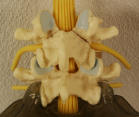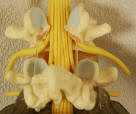
 Decompressive lumbar laminectomy involves removing
the lamina (roof of the spinal canal, covering the nerves) of the spine to decompress the nerves. Since the cause is
often thickened ligamentum flavum as well as
degenerated and arthritic facet joints,
sometimes a very wide removal of bone and ligament is needed. Above,
on the left, is a spine illustration showing the lamina intact, while on
the right, the lamina has been removed, and the spinal nerves (shown in yellow) can be seen. Fusion
of the spine may be added to the decompression when sufficient bone is removed
to cause the spine to become unstable. It may also be added if there
is severe low back pain, or mechanical instability.
Decompressive lumbar laminectomy involves removing
the lamina (roof of the spinal canal, covering the nerves) of the spine to decompress the nerves. Since the cause is
often thickened ligamentum flavum as well as
degenerated and arthritic facet joints,
sometimes a very wide removal of bone and ligament is needed. Above,
on the left, is a spine illustration showing the lamina intact, while on
the right, the lamina has been removed, and the spinal nerves (shown in yellow) can be seen. Fusion
of the spine may be added to the decompression when sufficient bone is removed
to cause the spine to become unstable. It may also be added if there
is severe low back pain, or mechanical instability.
The operation is known as a lumbar decompressive
laminectomy, laminectomy, or a lumbar decompression. The most
commonly affected levels in the lumbar spine are L3, L4 and L5. When
the operation is performed in the cervical spine for spinal cord
compression, it is known as a cervical decompressive laminectomy.

